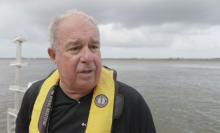
This column is a vehicle for a number of items in a bits-and-pieces, strictly opinion, sometimes irreverent format. Look for "Just Sayin'" to run once a week in this spot.
Brian Lapointe on What Ails Florida Bay
Harbor Branch/FAU marine biologist Brian Lapointe made a couple of points at the end of a Senate subcommittee last Wednesday that might have been overlooked. Certainly they bear repeating.
What he said is that while he agrees water storage south of Lake Okeechobee is important, moving more water south for the sake of Florida Bay is probably the worse thing you can do. It's only going to damage the bay further -- particularly the seagrasses and coral.

In his powerpoint presentation he said that while almost all phosphorus is removed in the storm treatment areas (STAs), most of the nitrogen is not, and flows downstream into Florida Bay. The nitrogen mixes with naturally occurring phosphorus in central and western Florida Bay where the blooms develop, he said.
"More water going south results in more algae, less light, low oxygen, and more seagrass stress -- and die-off. This is what happened back between 1991 and 1995 when increased water deliveries and a very wet El Nino year in 1995 triggered massive algae blooms that impacted the entire Florida Keys region, including a toxic red tide in the Keys in 1995," Lapointe told Sen. Rob Bradley's Senate Appropriations Subcommittee on the Environment and Natural Resources. "The blooms were followed by 40 percent loss of coral cover in the Florida Keys National Marine Sanctuary.
"We now know the problem isn't too much salinity, it's low dissolved oxygen killing the bay."
Lapointe, a part-time resident of the Keys, said George Barley, chairman of the Advisory Council for the Marine Sanctuary in its early days, really believed salinity caused blooms. But we now know he was wrong. And the National Academy of Science has concluded the same thing -- that science doesn't support the salinity theory.
Again, the real culprit is nitrogen. Which is why Lapointe always says "Florida Bay doesn't need water, it needs clean water."
Lapointe clarified his main point when I talked with him after the meeting. "What happens when water is discharged from the lake into the estuary is ... the nitrogen and phosphorus together are like a perfect storm. Nitrogen is a massive growth hormone. Move the water south toward the bay and you'll see the same thing there -- the blooms will expand with it. You're going to have algal blooms in Florida Bay same as you do after water is discharged into the St. Lucie estuary."
Have a look at the meeting on The Florida Channel here. Lapointe is the second presenter.
He ended his presentation with a warning: "You have to be very careful sending this water south," he said. "Use sound science."
Considering Bradley and Senate President Joe Negron plowed ahead the next day, filing the bill that would authorize a $2.4 billion land purchase for a 60,000-acre reservoir in the EAA, Lapointe's words have even more significance. And they shouldn't fall on deaf ears.
Thanks for Filing the High-Speed Passenger Rail Safety Act
Maybe my colleague Ed Dean wasn't trying to disparage the Treasure Coast opponents of All Aboard Florida/Brightline in his Thursday story, "Will More Taxpayer-Funded Lawsuits Derail All Aboard Florida in 2017?" -- but he certainly wasn't encouraging them either.
I think they're heroes.
Now let me ask this: How many people realize Florida has no law or regulation governing high speed rail safety? In a state that prides itself on "safety first" -- nothing.
How can anybody not be a fan of the fight these folks are putting up on behalf of quality of life in their communities? Florida NOT All Aboard, Citizens Against Rail Expansion in Florida (CARE FL), whole counties voting to pay for legal fees -- they're all that stand between sanity/safety and All Aboard Florida's many-tentacled railroad hell.
What we know is, All Aboard Florida's plans are to send as many as 32 high-speed passenger trains a day through the heart of what basically are small communities. Think about how much of life this is going to negatively affect -- in all, thousands of school children, first responders, pedestrians and residents.
These trains aren't stopping to pick up a single passenger. No passenger service in Martin, St. Lucie, Indian River or Brevard counties. No benefit for residents. No jobs, no rides.

It gets worse. As if the passenger trains aren't enough, the railroad is adding even more freight trains, some of which may carry hazardous materials along the Miami-Orlando and all-points-north route, increasing the risk of something going hideously wrong.
The cherry on the top is AAF's nonchalance about the cost of making the route safe. We have an octopus of a company here taking zero responsibility for the safety of hundreds of thousands of people along its rail line.
AAF wants Treasure Coast communities to pay for maintaining the upgrades necessary to protect themselves from these dangerous trains. Think about that for a moment.
I have to confess, I've been remiss in not congratulating and thanking Debbie Mayfield, R-Melbourne in the Florida Senate and MaryLynn Magar, R-Hobe Sound, Gayle Harrell, R-Stuart and Erin Grall, R-Vero Beach in the House who filed legislation Jan. 17 to create the Florida High-Speed Passenger Rail Safety Act.
If Ed Dean were right, these legislators wouldn't have jumped in as a team to do something positive for their AAF-affected constituents.
Have a look at Senate Bill 386 and call up the bill text.
This legislation will hold AAF's feet to the fire, making it solely responsible for the cost of upgrading and installing the appropriate safety measures desperately needed at high-speed rail crossings, protecting citizens' safety and pocketbooks.
“I find it quite astounding that Florida does not have any measures in place to address high-speed rail when there is a statewide project under way that will crisscross through my community, many others between Miami and Orlando, and potentially up Florida’s entire east coast,” said Mayfield.
“I can tell you that to date, I have not heard one thing from AAF about what they are going to do to ensure safety features are in place to protect the public around these fast-moving trains. This legislation is really designed to protect all Floridians from accidents and injuries at these dangerous railroad crossings across the state.”
Said Magar, “This legislation not only protects Floridians from the potential dangers of high-speed trains by ensuring the appropriate safety technology is in place, but also protects their tax dollars by ensuring the appropriate entity pays for those upgrades,” said Magar. “Local governments should not have to absorb the costs of protecting their citizens from a private project. This good bill puts a stop to so-called private railroad companies financing their business ventures on the backs of hard-working taxpayers.”
The Florida High-Speed Passenger Rail Safety Act does these things and more:
- Provides the Florida Department of Transportation (FDOT) with the authority to regulate railroad companies in Florida;
- Establishes minimum safety standards for high-speed passenger rail;
- Requires FDOT to identify pedestrian traffic generators;
- Stipulates that a railroad company operating high-speed passenger rail is solely responsible for all rail corridor improvements or upgrades; and
- Outlines state reporting requirements for railroad companies regarding accidents, injuries, and fatalities.
This is an important bill for a great many Floridians now and in the future. This is how we protect our people. It deserves all legislators' support.
Reach Nancy Smith at nsmith@sunshinestatenews.com or at 228-282-2423. Twitter: @NancyLBSmith


